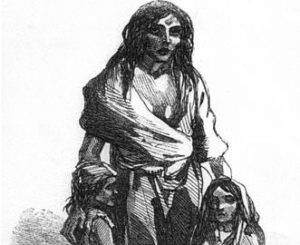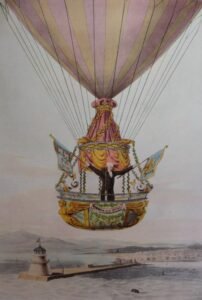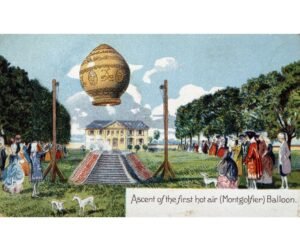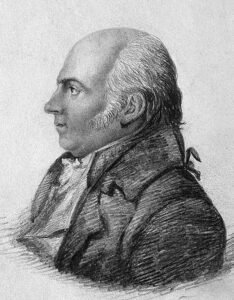


I have lived in Oxford for more than 30 years. Oxford, where Richard Lovell Edgeworth spent a very much shorter time as a student, is the county town of the village in which Maria Edgeworth was born and where her maternal ancestors lived. Coincidentally it was also the hometown of James Sadler. Maria and her father Richard Lovell Edgeworth, along with several other members of the Edgeworth family, witnessed James Sadler’s momentous hot-air balloon launch from Dublin in 1812.

My talk at the Edgeworth Festival in May 2023 drew together these connections to reveal, firstly, a little about Maria’s Oxfordshire ancestors. Secondly, it also exposed Richard Lovell Edgeworth’s associations with the originators of the very first phase of aeronautics. And thirdly, uncovered the context of that intrepid balloon flight across (most of) the Irish Sea.
After ‘six dissipated months’ at Trinity College, Dublin, Richard Lovell Edgeworth (1744–1817) was sent to the Oxford college of Corpus Christi as a gentleman-commoner in October 1761. His father, Richard (1701–1770) hoped that his Dublin-born friend Paul Elers (1700–1781) would be able to moderate Edgeworth’s unruly behaviour. The two men had met while studying law in London.
As a result, Richard Lovell Edgeworth became a familiar visitor to the Elers’ sizeable estate at Black Bourton, a village about 15 miles west of Oxford. So far, so good, but as a consequence, Richard Lovell Edgeworth also became familiar with Paul Elers’ array of unmarried daughters. Rather too familiar indeed with Anna Maria (1743–1773). She was the second oldest, with whom he felt compelled to elope to Scotland to marry when she became pregnant, as they were both underage. This is somewhat in keeping with other matrimonial shenanigans. These frequented the histories of both the Edgeworth family and that of the Hungerfords (Elers’ wife’s family), but that’s for another time … Suffice to say that Maria was born in the Hungerfords’ mansion of Bourton Place – since demolished – in 1768.
Meanwhile, in Oxford, the future aeronaut, engineer, chemist, and inventor, James Sadler (1753–1828), had probably just started his apprenticeship that year as a cook, following his father’s trade. It was not a profession he pursued with much enthusiasm, however, because in October 1784 – with apparently no collaborators – he became the unlikely first Englishman, and arguably Briton, to fly, in a hot-air balloon of his own design. This was only a year after the French Montgolfier brothers had invented the very first one.


Cue Richard Lovell Edgeworth! Always abreast of new technological developments! He had wasted no time in making contact with the Montgolfier brothers, and conducted experiments of his own at Edgeworthstown (as too did his close friend Erasmus Darwin at Derby). Considerately enough, Richard Lovell Edgeworth decided to curtail his interest on account of ‘the danger of setting the surrounding thatched cottages on fire’. Some years later, however, he had a fruitful, mutually congratulatory, meeting with Joseph Montgolfier in Paris. Apparently, at this meeting parachutes were a principal topic of conversation.
Although their societal, educational and financial backgrounds were very different, Richard Lovell Edgeworth and James Sadler were similar in respect of having inquiring, inventive minds. They were always interested in new ideas and in improving existing ones. Sadler, after eight balloon ascents, turned his attention to engine design. Furthermore, and, more pertinently in the context of this article, he started fabricating laboratory equipment for the Oxford Professor of Chemistry, Thomas Beddoes (1760–1808). Soon, Thomas described Sadler as his ‘laboratory genius’ and ‘a perfect prodigy in mechanics’. When Beddoes felt obliged to relocate to Bristol in 1793 – conservative Oxford took a dim view of his democratic principles – he took Sadler with him. There, Sadler helped him to set up a medical establishment he called the Pneumatic Institute.

Beddoes, of course, subsequently married Richard Lovell Edgeworth’s daughter Anna (1773–1824). In the end, it was Richard Lovell Edgeworth who helped Beddoes to find suitable premises in Bristol. At this point, one feels that he and Sadler would probably have met. There is no proof of this, though. Therefore, it is not until October 1812, in Dublin, that the two men can categorically be stated to have been in close proximity.
Maria was there too, among the thousands of people – balloon ascents always attracted huge audiences – who came to watch James Sadler attempt to become the first man to cross the Irish Sea by air, a feat which had eluded all aspirants since the 1780s. Maria’s letter to her step-mother, Frances, contains the most evocative and descriptive account of any balloon launch of the period. Sadler failed in his attempt – in dramatic, close-to-drowning, fashion – but five years later his son Windham (1796–1824) became the first person to succeed in this quest when he landed safely in Anglesey.
The book contains detailed descriptions of all the early Irish balloon ascents undertaken or facilitated by the Sadlers.
Before this crowning achievement of his aeronautical career, however, Windham had made ascents the previous year from Cork (the first ever seen in that city) and Dublin (when he too might well have perished, after landing in the Bog of Allen one dark, chilly November night). It was also in Windham’s balloon and with his help that the first woman ever to fly in Ireland (a Miss Thompson: probably Mary, probably from London) ascended in 1817. Windham Sadler made one last Irish flight from Dublin on 14 July 1824, but by the end of that same year, he would be dead: only Britain’s second ever aviation fatality.
Windham’s father James lived a further four years, but in impoverished anonymity. He was buried back where he was born, in Oxford, where there is only token public acknowledgment of this great pioneer of aeronautics. He deserves better. But so too does Richard Lovell Edgeworth. Although worlds apart in so many ways, these two men probably suffer from the same restless tendency of never settling to one of the many different fields in which they were so clearly proficient. Jacks of all trades tend to be easily overlooked by posterity, even when, arguably, James Sadler and Richard Lovell Edgeworth were actually also masters of many of those self-same trades.
Written by: Mark Davies, an Oxford local historian, guide, public speaker, and author (www.oxfordwaterwalks.co.uk). His biography of James and Windham Sadler – ‘King of all Balloons’: the Adventurous Life of James Sadler, the first English Aeronaut – is published by Amberley Publishing, Stroud.
The best way to keep in touch and to be aware of our events
Don’t forget to confirm your subscription in the Email we just sent you!

Please pre-book your visit over Christmas at least 24h in advance via Email or Online booking.
MondayClosed
Tuesday10:00 AM - 5:00 PM
Wednesday10:00 AM - 5:00 PM
Thursday10:00 AM - 5:00 PM
Friday10:00 AM - 5:00 PM
Saturday11:00 AM - 5:00 PM
Sunday11:00 AM - 5:00 PM
Adult €7.50
Children 10 to 16 €3
2 Adults & 2 Children €15
Adult is 16 years+
Family Ticket is 4 family members together
Children under ten are free but must be accompanied by an Adult

The Maria Edgeworth Centre is operated under the direction of the Edgeworthstown District Development Association (EDDA) – a Not for Profit Voluntary Community based registered charity Reg:223373. Registered Charity Number 20101916
© 2023 Maria Edgeworth Centre – All Rights Reserved
On the 17th of August 2024 as part of Heritage Week, with support from the County Heritage Officers, the Heritage Council, Longford County Council Libraries, Archives, Arts and Heritage,
IMMA, OPW and the Computer and Communications Museum Ireland on the NUIG Campus,
Ray Jordan and volunteers from the Maria Edgeworth Centre aim to simulate Edgeworth’s 1803 transmission by telegraph.
Click the link below to learn more or to register to attend either in person or via Zoom.
Join us for this recreation of a key moment in the history of communications